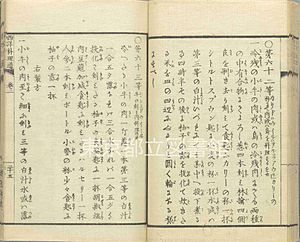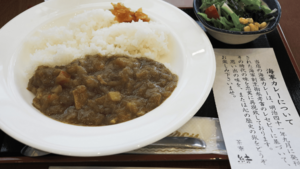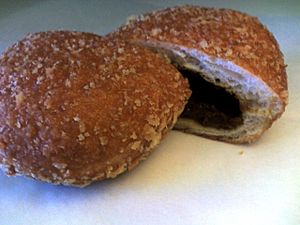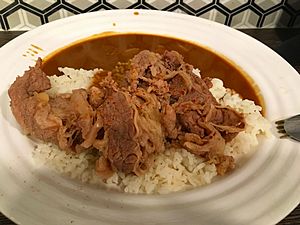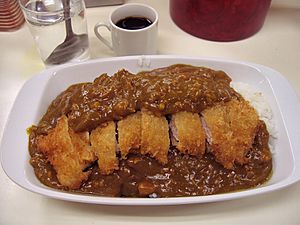Japanese curry facts for kids
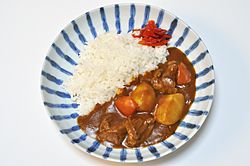
A plate of Japanese style curry with rice
|
|
| Type | Curry |
|---|---|
| Place of origin | Japan |
| Main ingredients | Vegetables (onions, carrots, potatoes), meat (beef, pork, chicken) |
| Variations | Karē raisu, karē udon, karē-pan |
Japanese curry (カレー, karē) is a super popular dish in Japan! It's usually served in three main ways:
- curry over rice (カレーライス, karē raisu) (this is the most common, often just called "curry")
- Curry udon (curry over noodles)
- curry bread (a tasty pastry filled with curry)
Japanese curry uses lots of different vegetables and meats. The main veggies are onions, carrots, and potatoes. For meat, people usually choose beef, pork, or chicken. One special type is Katsu curry, which is a crispy, deep-fried cutlet (like tonkatsu, usually pork or chicken) served with Japanese curry sauce.
Contents
What is Japanese Curry?
Curry first came from India. It was brought to Japan by the British. The Imperial Japanese Navy started eating curry to help prevent a sickness called beriberi. Even today, the Japan Maritime Self-Defense Force often serves curry on Fridays! It's a healthy meal and easy to cook for many people.
Japanese curry became very popular and you could buy it in supermarkets and restaurants by the late 1960s. Over time, it changed a lot to fit Japanese tastes and ingredients. Because of these changes, Japanese curry is now quite different from curries in other parts of the world. It's so unique that it's almost like its own national dish in Japan!
How Japanese Curry Became Popular
Curry arrived in Japan during the Meiji era (1868–1912). At that time, India was under British rule. British officers brought curry powder to Japan. It was seen as a "Western food" because it came from the West. The Japanese word for curry, karē, probably came into use around the 1860s. This was when Japan started connecting with the British Empire after a long period of being closed off.
By the 1870s, curry was being served in Japan. It quickly became a regular part of the Japanese diet. Karē raisu (curry rice) is the most common way to eat it. Early mentions of "rice curry" appeared in Japanese cookbooks in 1872. The dish became more widely known thanks to Professor William S. Clark in 1877.
Curry really took off when the Japanese Navy and Army started eating it in the early 1900s. After the military, it became common in school cafeterias too. By the year 2000, more people ate curry than even sushi or tempura! The Imperial Japanese Navy played a big role in its fame. Their sailors ate a meat stew with curry, similar to the British Royal Navy. This was called Kaigun Kare ("Navy curry"). It included beef or chicken, potatoes, onions, carrots, rice, and curry roux.
Today, karē is one of the most popular everyday meals for Japanese people.
Making Japanese Curry Sauce
Curry sauce (カレーソース, karē sōsu) is poured over cooked rice to make curry rice. To make the sauce from scratch, you would fry curry powder, flour, and oil to create a thick base called a roux. This roux is then added to stewed meat and vegetables and simmered until it thickens.
At home, most Japanese families use instant curry roux. This comes in blocks or powder. It already contains curry powder, flour, oils, and other flavors. It's super easy to use, which is why curry rice is so popular and simple to make compared to many other Japanese dishes. You can also buy pre-made curry in sealed bags that you just heat up.
Instant curry roux was first sold in powder form in 1926. Block form came out in 1956. Big companies like House Foods and S&B Foods are well-known for their curry mixes. Sometimes, curry is even marketed to kids using characters from video games and anime!
How Japanese Curry is Served
Japanese curry rice can be served on a flat plate or in a soup bowl. The curry sauce is poured over the rice. Japanese short-grain rice is usually preferred because it's sticky and round. People usually eat curry with a spoon, not chopsticks, because the curry is a liquid sauce. Curry rice is often served with side dishes like fukujinzuke (pickled vegetables) or rakkyō (pickled scallions).
Other Types of Japanese Curry
There are many fun variations of Japanese curry:
- Katsu curry (katsu karē, カツカレー): Curry rice with a crispy, breaded pork cutlet on top.
- Dry curry (ドライカレー, dorai karē): This can be curry-flavored fried rice, or curry rice with a drier, minced meat curry sauce.
- maze karē (混ぜカレー): Curry rice where the sauce and rice are already mixed together.
- karē don (カレー丼): Curry sauce, made thicker and flavored with Japanese ingredients like mentsuyu, served over a bowl of rice.
- aigake (合がけ): Rice served with both curry sauce and hayashi sauce (a beef and onion sauce).
- yaki karē (焼きカレー): Curry rice topped with a raw egg and baked in an oven. It started in Kitakyūshū.
- ishiyaki karē (石焼きカレー): Curry sauce with rice served in a hot stone bowl, similar to dolsot bibimbap.
- Soup curry (スープカレー, sūpu karē): A watery, broth-like curry sauce with big pieces of ingredients like a chicken leg and chunky vegetables. It's popular in Hokkaidō.
Local Japanese Curries
Since the late 1990s, many special regional curries have appeared. These are often sold in vacuum-sealed bags. They use local ingredients from different parts of Japan. Some examples include:
- Hokkaido sika deer curry (えぞ鹿カレー, ezoshika karē) from Hokkaidō.
- Scallop curry (ほたてカレー, hotate karē) from Aomori Prefecture.
- Mackerel curry (サバカレー, saba karē) from Chiba Prefecture.
- Apple curry (リンゴカレー, ringo karē) from Nagano Prefecture and Aomori Prefecture.
- Nattō curry (納豆カレー, nattō karē) from Mito, Ibaraki.
- Matsusaka beef curry (松阪牛カレー, Matsusaka gyū karē) from Mie Prefecture.
- Oyster curry (牡蠣カレー, kaki karē) from Hiroshima Prefecture.
- Bitter melon curry (ゴーヤーカレー, gōyā karē) from Okinawa Prefecture.
These local curries are also used to help boost tourism. For example, Yokosuka navy curry is sold in Yokosuka to celebrate its history as a naval base.
Japanese Curry Around the World
Japanese-style curry is popular in other countries too!
South Korea
Curry came to South Korea when Japan ruled Korea. It's very popular there, especially in diner-style restaurants and Japanese restaurants. You can easily find pre-made curry and mixes in supermarkets.
Elsewhere
You can find Japanese curry mixes outside Japan and Korea in supermarkets with a Japanese section or in Asian food stores. Many online stores also sell them.
CoCo Ichibanya (also called Kokoichi) is a huge Japanese curry restaurant chain. They have over 1,200 restaurants in Japan! They also have branches in many other countries, including China, Hong Kong, Taiwan, Korea, Singapore, Indonesia, Philippines, Thailand, United Kingdom, Hawaii, California, and India.
See also
 In Spanish: Curry japonés para niños
In Spanish: Curry japonés para niños


